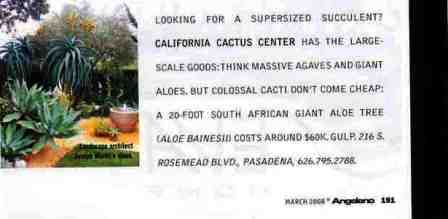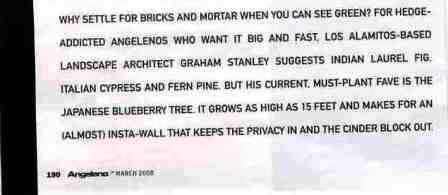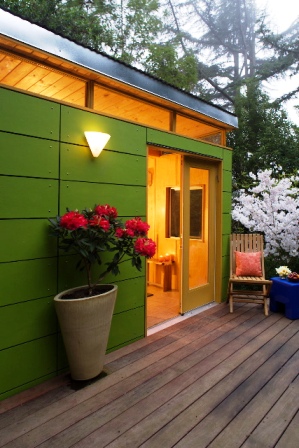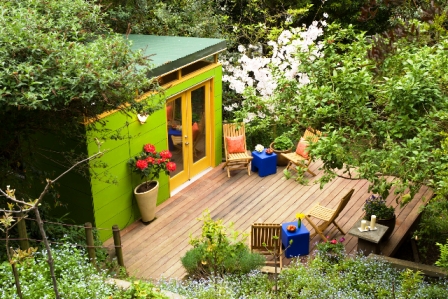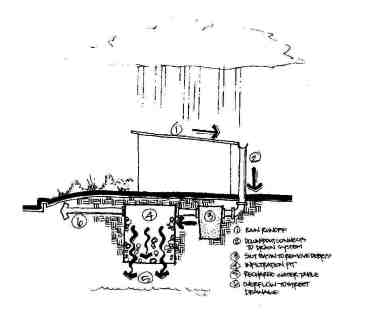Where has the time disappeared to? What have I done to fill my days since last posting on March 20th?
Ignoring the chance to write here is like ignoring my running schedule because of “work” demands. Oh, the work will always be here, but the creativity (and exercise), now that’s something I shouldn’t neglect. Even though the promotion and travel schedule for Stylish Sheds is looming, I have been telling myself not to let another day go by without posting here.
Yet, I find I’m always “catching up” and apologizing for it. Replying to emails of friends’ and professional colleagues with the opening line: “I’m sorry I’ve been out of touch; I’m playing catch-up on 100 unanswered emails,” or “I’m catching up on housework, or the bills, or the gardening, because I just finished a killer deadline.” It’s sort of the everyday currency of my life. I borrow from time and then I have to pay it back. Choices, choices. I choose to accept assignments that interest, intrigue or challenge my curiosity. Then I choose to neglect everything else that’s non-essential in order to report and write the article. Then I choose to set keyboard and telephone aside so I can “catch up” on grocery shopping, garden-tending and family-time.
Catching up, I think: What have I been up to? Here’s a brief recap, for as far back as my memory serves (about one month, these days):
Day One, Death Valley
In late March, we spent several days in Death Valley for spring break. Let’s just say Mom had more fun than her two sons, who tired of all the driving, hiking, heat, intense sun, and more. Yet, being with dear friends Sara and Malcolm (a gifted tour guide) made it all the more worthwhile. As I tell my boys, “We need to meet our surroundings, up close and personal. As we learn more about California’s geography, geology and history, we feel more like Californians.” Yikes! That’s why we went to Death Valley.
God’s creation overpowers the frail human efforts of emulating the colorful rock formations at Artist’s Palette, Death Valley
Sunrise over Zabriskie Point. Worth getting out of bed early to experience. Truly breathtaking and awe-inspiring
While en route, however, we couldn’t resist stopping for photo-ops in a little blink-of-a-town called “Pearsonville.” It is known as the hubcap capital of the world. Seriously. Here are the photos to prove it.
These roadside attractions gave us a glimpse of California’s quirky nature. And hey, now you know how to turn a wayward hubcap or two into a gleaming expression of kitschy garden art!
 In early April, on April 1st to be exact, I spent no fewer than 14 hours and 205 miles behind the wheel of my ol’ Subaru, ushering Justin Hancock around LA to see local gardens. Justin is the “Garden Doctor” for Better Homes & Gardens’ web site, bhg.com. You can read him here. He is truly one of those “next generation gardeners” that everyone in the green industry is striving to attract. Yet, Justin is miles ahead of most of us, a true plantsman who takes seriously his craft as an editor, educator and communicator. We actually filled our time, our hours on the freeway between stops, gabbing away about plants, gardening and all sorts of ideas about new media. Look for big things coming from this guy.
In early April, on April 1st to be exact, I spent no fewer than 14 hours and 205 miles behind the wheel of my ol’ Subaru, ushering Justin Hancock around LA to see local gardens. Justin is the “Garden Doctor” for Better Homes & Gardens’ web site, bhg.com. You can read him here. He is truly one of those “next generation gardeners” that everyone in the green industry is striving to attract. Yet, Justin is miles ahead of most of us, a true plantsman who takes seriously his craft as an editor, educator and communicator. We actually filled our time, our hours on the freeway between stops, gabbing away about plants, gardening and all sorts of ideas about new media. Look for big things coming from this guy.
BH&G’s Justin Hancock, touring Shirley Bovshow’s lovely garden
Justin and Marilee Kuhlmann, touring her project in Santa Monica. They are seen here, intently discussing a plant combination
Other than these outings, I’ve been spending lots of time interviewing great gardeners, designers, architects and artists, and thinking of ways to promote the heck out of Stylish Sheds and Elegant Hideaways. The book will FINALLY be published on April 29th. To hear my recent radio interview with Fran Halpern, host of “Beyond Words” on KCLU (Ventura/Santa Barbara county’s NPR station), follow this link.












